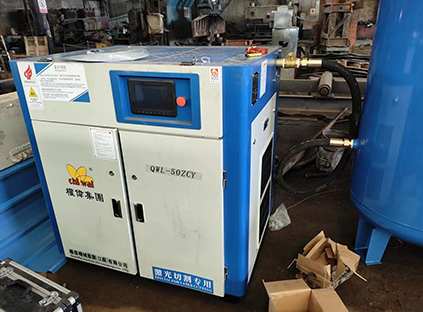Screw air compressors are widely used in various industries, providing a reliable source of compressed air. However, a common issue faced by operators is excessive moisture content in the compressed air, which can lead to equipment damage, decreased efficiency, and compromised product quality. This article aims to explore effective methods to reduce moisture in screw air compressors.

1. Understanding the Problem:
To effectively address the issue of excessive moisture, it is crucial to understand the factors contributing to its presence. Moisture in compressed air results from ambient air humidity, and it gets condensed during the compression process. Higher humidity levels and improper compressor operation exacerbate the problem. By comprehending these factors, appropriate solutions can be implemented.
2. Maintenance and Regular Inspection:
Regular maintenance and inspection of the screw air compressor are vital for ensuring optimal performance and reducing moisture content. This includes monitoring and cleaning air filters, checking for leaks or damaged components, and ensuring proper lubrication. By adhering to maintenance schedules, potential issues can be identified and resolved promptly, reducing the chances of moisture-related problems.
3. Install a Moisture Separator:
Installing a moisture separator is an effective solution for removing excess water from compressed air. The moisture separator is typically placed downstream of the compressor, where it separates moisture from the compressed air stream through centrifugal force or other mechanisms. Regular maintenance and draining of the moisture separator are essential to ensure its efficient operation.
4. Implement a Pre-cooler:
A pre-cooler can be utilized to reduce the temperature of the compressed air before it enters the moisture separator. Lowering the air temperature increases the likelihood of moisture condensation, allowing the separator to remove more water from the compressed air. Pre-coolers can be water-cooled or air-cooled, depending on the specific requirements of the compressor system.
5. Dryers and Filters:
Using air dryers and filters is another effective way to reduce moisture content in compressed air. Refrigerated dryers, desiccant dryers, or membrane dryers can be employed, depending on the desired level of moisture removal. Additionally, installing high-quality filters can help capture water droplets and particulate matter, ensuring cleaner and drier compressed air.
6. Control Ambient Conditions:
Controlling the ambient conditions in the compressor room can significantly impact moisture levels in the compressed air. Proper insulation, ventilation, and temperature control can minimize the ingress of humid air into the compressor, reducing the moisture content in the compressed air. Ensuring a well-sealed compressor room is crucial in this regard.
7. Regular Drainage of Moisture:
Draining accumulated moisture from the compressor system is imperative to maintain optimal performance. Automatic drains or manual valves can be installed at strategic points in the system to remove condensate regularly. Neglecting proper drainage can lead to increased moisture levels, corrosion, and damage to downstream equipment.
Excessive moisture in oil injected air compressor is a common issue that can negatively impact performance and product quality. By implementing a combination of regular maintenance, appropriate equipment installation, and control of ambient conditions, operators can effectively reduce moisture content in compressed air. Ultimately, these measures will result in improved productivity, energy efficiency, and extended equipment lifespan.